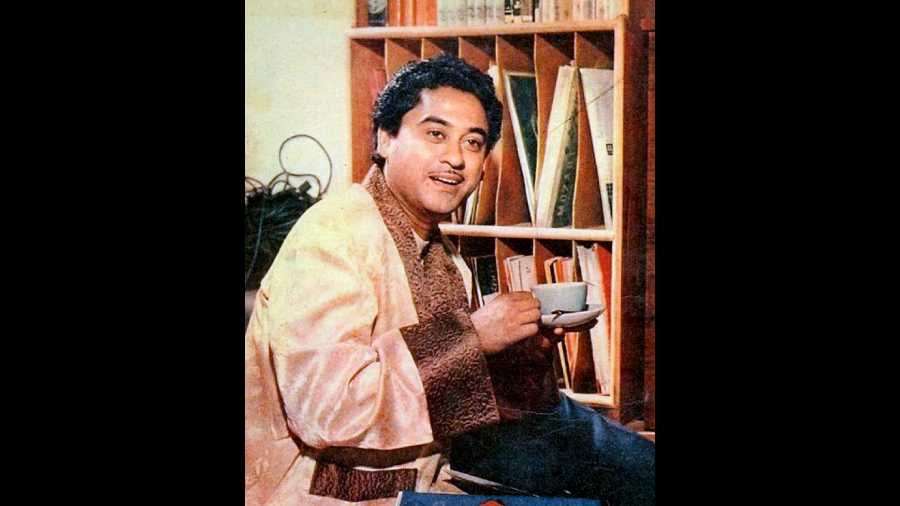Book: Kishore Kumar: The Ultimate Biography
Author: Anirudha Bhattacharjee and Parthiv Dhar
Publisher: HarperCollins
Price: ₹699
“Biography lends to death a new terror.” — Oscar Wilde
Biographers, as Wilde’s remark implies, have an onerous responsibility as they wield considerable power in shaping the character of the subject they are writing on. More so, if the subject left this world more than three decades ago. A biography of Kishore Kumar, the immeasurably talented, if moody, singing superstar who died in October 1987, is, therefore, bound to generate curiosity and excitement.
Kumar was a bit of everything: he was also an actor, director, composer, producer, writer and lyricist. The curious reader would like to know how Kumar managed to do all of this and achieve success, albeit in varying degrees. He was married four times; his second wife, Madhubala, was among Hindi cinema’s first big stars whose death shattered Kumar. How was he as a husband, as a father? There have been several stories about Kumar’s eccentricities: how he allegedly harassed producers; his fascination for the paranormal, his enviable collection of horror film videos — he was once famously photographed with a skull in his hand — and so on. But was he really eccentric, a difficult person to get along with, or was that an act? He was also a very sensitive person who liked to spend time by himself surrounded by his trees and could be generous to a fault — he once bailed out a then-unknown Satyajit Ray who was facing a funds crunch during the making of his seminal work, Pather Panchali.
In deciding to write about such a person, Anirudha Bhattacharjee — the author of two previous biographies on the composers, Rahul Dev Burman and S.D. Burman — and Parthiv Dhar took up a challenge, that of presenting Kishore Kumar, the artiste, the entertainer and the person, not just to a generation that grew up on his songs but also to the generation that was born after 1987.
The authors have documented how Kumar’s formative years in Khandwa, a small town in Madhya Pradesh where his father practised law, would go on to influence his later life. For instance, his exposure to the songs of K.L. Saigal, perhaps India’s first singing superstar who Kumar would count among his inspirations, and also to the yodelling technique he picked up from listening to the records of Jimmie Rodgers and Tex Morton.
A book on Kumar would also have to sketch the rise to popularity of his elder brother and the actor, Ashok Kumar. By the time Kumar joined college in Indore in 1946, Ashok Kumar was an established star in Bombay and Kumar would often visit his brother. These visits put Kumar on the path to his future career as a singer and an actor. Bhattacharjee and Dhar detail Kumar’s progression in Bombay — how he became a producer, composer, director, and then took to writing songs for his movies, his marriage to Madhubala, her illness and subsequent death, his confrontations with the income tax department — and also his failed ventures: he would often announce films only to discard them seemingly without any reason.
Although Kumar enjoyed considerable success through the Fifties and Sixties, his meteoric rise to fame, and possibly fortune, came with the release of Shakti Samanta’s Aradhana in 1969 that catapulted a young Rajesh Khanna to superstardom. Kumar was suddenly seen as the voice of the young, a tag that kept gaining credibility as Khanna delivered one hit film after another, many of whose music was composed by the talented Rahul Dev Burman, aka Pancham. The trio of Kumar, Khanna and Pancham would combine for some of the most memorable music in Hindi cinema through the Seventies.
This is where the biography comes up short. The authors have dealt with Kumar’s post-Aradhana phase, arguably when he reached his zenith as a singer and the reason why his legacy lives on even 35 years after his death, in much less detail than they have his earlier career.
For example, the book devotes quite a few pages to Kumar’s scrap with the government during the Emergency that prompted a ban on his songs being played on State-run radio. But his tiff with Amitabh Bachchan, probably India’s biggest superstar, has been mentioned in passing. In Pancham composed Pukar, the composer and not Kumar, sang for Bachchan; Kumar lent his voice to Randhir Kapoor. Readers would have liked to know why.
The success of a biography lies in the research and the extensive exploration of the subject to bring the stories of the past to present and future generations. The research by the authors is commendable — they even mention car registration numbers and class roll numbers. The book is a treasure trove of information for trivia-seekers, quizzers and quizmasters — every chapter is peppered with names of unheard-of or lesser-known songs and films. The authors have also provided 47 pages of notes that supplement the information in the chapters.
Moreover, the book doesn’t attempt to paint any one picture of Kumar. Instead, it invites the readers to navigate through the mountain of information to form their own idea of the person that was Kishore Kumar.











